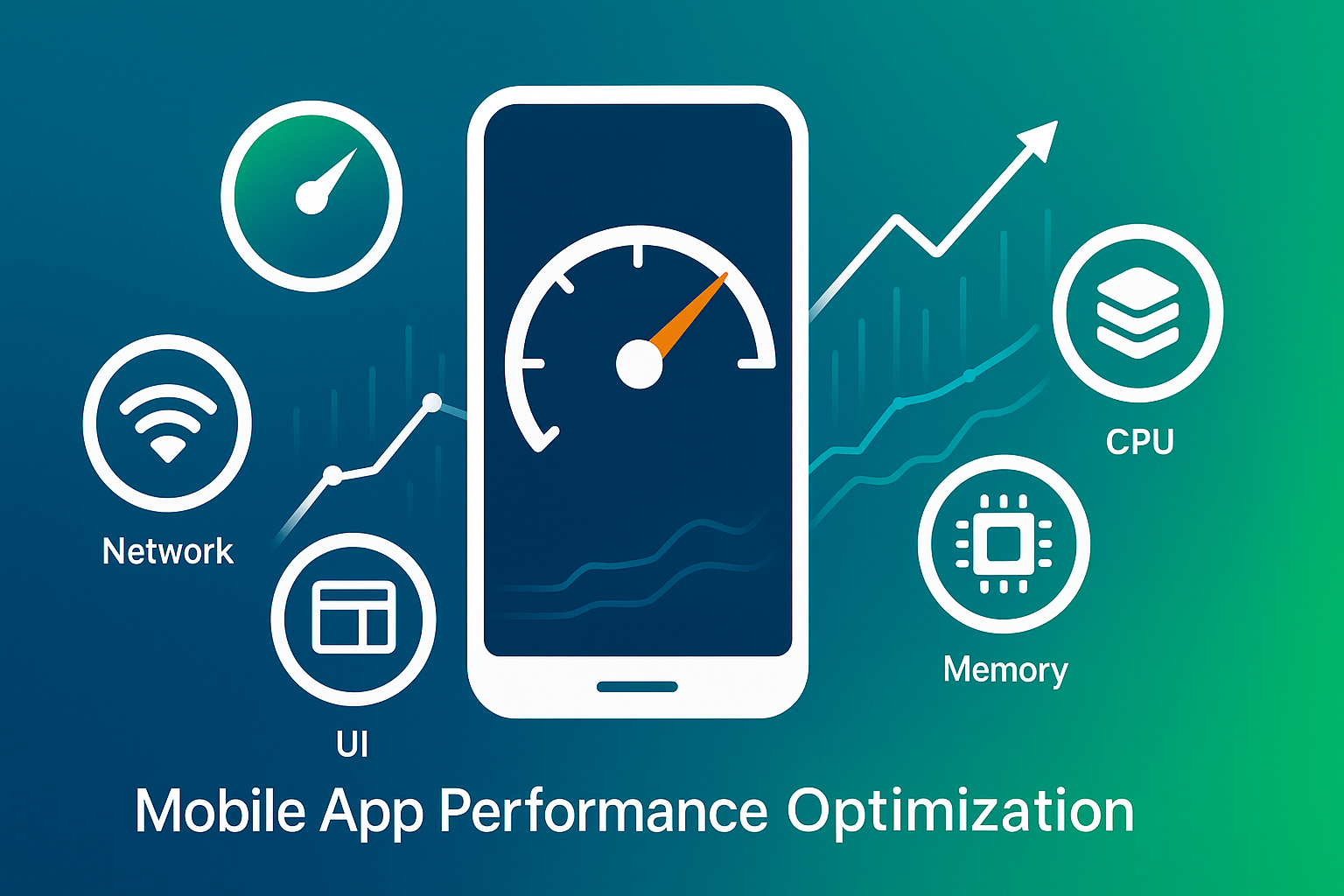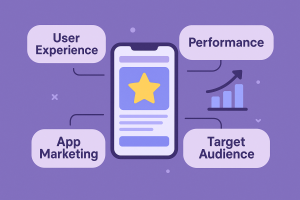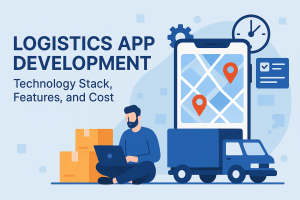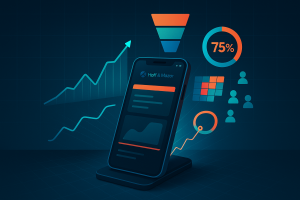Mobile apps have become essential tools for businesses and consumers alike. However, as user bases grow and traffic increases, many apps begin to experience performance issues that can frustrate users and damage brand reputation. Understanding and addressing these performance bottlenecks is crucial for maintaining a competitive edge in the crowded app marketplace.
Mobile app performance optimization bottlenecks occur when a component or resource limits the overall throughput of your application. These issues become particularly problematic in high-traffic scenarios where thousands or even millions of users might be accessing your app simultaneously. From slow load times to battery drain and crashes, these performance problems can lead to poor user experiences and ultimately, user abandonment.
This comprehensive guide explores the common performance bottlenecks that plague high-traffic mobile applications and provides practical strategies to identify, analyze, and overcome these challenges. Whether you’re a developer, product manager, or business owner, this article will equip you with the knowledge and tools needed to optimize your mobile app for peak performance, even under heavy user loads.
Understanding Mobile App Performance Bottlenecks
What Are Performance Bottlenecks?
Performance bottlenecks are constraints that limit your app’s ability to handle increased loads efficiently. These constraints might exist in various components of your application, from the frontend UI to backend services or network connections.
In high-traffic mobile apps, bottlenecks become amplified as more users engage with your app simultaneously. What might seem like minor inefficiencies during development can quickly escalate into major performance issues when scaled to thousands of concurrent users.
Common Types of Performance Bottlenecks
1. Network-Related Bottlenecks
Network performance often represents the most significant bottleneck for mobile applications. Issues like slow API responses, inefficient data transfer, and poor connectivity handling can severely impact user experience.
Many apps make the mistake of not optimizing their network requests, resulting in unnecessary data transfers and wasted bandwidth. Additionally, failure to implement proper caching strategies means that apps repeatedly download the same resources, further straining network resources.
2. UI Rendering Bottlenecks
The user interface is where performance issues become most visible to users. Sluggish animations, delayed responses to user interactions, and jerky scrolling are clear indicators of UI rendering problems.
Complex layouts, inefficient view hierarchies, and excessive drawing operations can cause the main thread to become overloaded, resulting in UI freezes and poor responsiveness. As user traffic increases, these issues become more pronounced, especially on lower-end devices.
3. Memory Management Issues
Memory leaks and inefficient memory usage represent another common category of performance bottlenecks. As users interact with different features of your app, memory consumption gradually increases if resources aren’t properly released.
In high-traffic scenarios, memory issues can lead to more frequent garbage collection cycles, causing noticeable stutters in the user experience. In extreme cases, excessive memory consumption can trigger system-initiated app terminations.
4. Database and Storage Operations
Inefficient database queries, excessive disk I/O operations, and poor data management strategies can significantly slow down app performance. As user data grows, these inefficiencies become more apparent and problematic.
Many apps fail to implement proper pagination, batch processing, or query optimization techniques, resulting in slow load times and unresponsive interfaces during data-intensive operations.
5. CPU-Intensive Processing
Heavy computational tasks like image processing, complex calculations, or large dataset manipulations can overburden the CPU and drain battery life. When these operations are performed on the main thread, they directly impact UI responsiveness.
In high-traffic apps, efficient use of computational resources becomes even more critical, as server-side processing might be handling requests from thousands of users simultaneously.
Identifying Performance Bottlenecks
Performance Monitoring and Profiling
Before you can fix performance bottlenecks, you need to identify them accurately. Modern mobile development platforms provide various tools for monitoring and profiling app performance.
For Android development, Android Profiler offers insights into CPU, memory, network, and energy usage. For iOS, Xcode’s Instruments suite provides similar capabilities with tools like Time Profiler and Allocations Instrument.
Third-party monitoring solutions can also provide valuable real-world performance data, helping you understand how your app behaves across different devices and under various network conditions.
Key Performance Metrics to Track
To effectively identify bottlenecks, focus on these essential performance metrics:
- App Launch Time: The time it takes for your app to become fully interactive after a user taps the icon.
- UI Response Time: How quickly your app responds to user interactions like taps, swipes, and other gestures.
- Network Request Latency: The time it takes to send requests and receive responses from your backend services.
- Frame Rate: The smoothness of animations and scrolling, ideally maintaining 60 frames per second.
- Memory Usage: How efficiently your app utilizes and releases memory resources.
- Battery Consumption: The rate at which your app drains the device’s battery.
- Crash Rate: The frequency of unexpected app terminations.
By establishing baseline measurements for these metrics and tracking them over time, you can identify degrading performance trends before they become critical issues.
Strategies for Overcoming Network Bottlenecks
Optimize API Design and Integration
The communication between your mobile app and backend services often represents the most significant performance bottleneck. Cross-platform mobile app development approaches need particular attention to API optimization to ensure consistent performance across different operating systems.
Consider these API optimization strategies:
- Design Efficient Endpoints: Create purpose-specific endpoints that return only the necessary data for each use case, reducing payload sizes.
- Implement Pagination: For large datasets, implement pagination to load data in manageable chunks rather than all at once.
- Use Compression: Compress API responses to reduce data transfer sizes and speed up loading times.
- Consider GraphQL: Unlike traditional REST APIs, GraphQL allows clients to request exactly the data they need, reducing over-fetching.
Implement Effective Caching Strategies
Caching is one of the most powerful techniques for improving network performance. By storing previously fetched data locally, you can significantly reduce network requests and provide a more responsive user experience.
Effective caching strategies include:
- HTTP Caching: Utilize standard HTTP caching mechanisms like ETag and Cache-Control headers.
- In-Memory Caching: Keep frequently accessed data in memory for immediate access.
- Persistent Caching: Store data on disk for access across app sessions.
- Image Caching: Implement specialized solutions for caching images to avoid repeated downloads.
When building scalable mobile apps, caching becomes even more crucial as it directly impacts how well your application can handle increased user loads.
Optimize for Different Network Conditions
Mobile apps must perform well across various network conditions, from high-speed Wi-Fi to spotty cellular connections. Implementing network-aware features can significantly improve user experience:
- Adaptive Quality: Adjust content quality based on network speed (e.g., loading lower-resolution images on slow connections).
- Background Syncing: Perform non-critical updates when the device has a strong connection.
- Offline Mode: Allow core functionality to work without an internet connection.
- Request Prioritization: Prioritize critical requests over less important ones during poor connectivity.
Enhancing UI Performance
Optimize Layouts and View Hierarchies
Complex layouts and deep view hierarchies can significantly impact rendering performance. Creating responsive mobile UI requires careful attention to layout optimization:
- Flatten View Hierarchies: Reduce the depth of your view tree by eliminating unnecessary container views.
- Use ConstraintLayout (Android) or Stack Views (iOS): These layout systems are designed for performance and flexibility.
- Avoid Overdraw: Prevent drawing the same pixel multiple times by optimizing view overlap.
- Implement View Recycling: Reuse view objects rather than creating new ones, especially in lists and scrolling containers.
Efficient Resource Management
Resource management significantly impacts UI performance, particularly for image-heavy applications:
- Optimize Images: Use appropriately sized and compressed images for different screen densities.
- Lazy Loading: Load resources only when they’re needed rather than all at app launch.
- Vector Graphics: Use vector graphics when possible to reduce memory usage and maintain quality across different screen sizes.
- Resource Pooling: Implement object pooling for frequently created and destroyed resources.
Smooth Animations and Transitions
Animations and transitions can enhance user experience, but they must be implemented efficiently to avoid performance issues:
- Use Hardware Acceleration: Leverage the GPU for complex animations.
- Avoid Blocking the Main Thread: Perform animation calculations off the main thread when possible.
- Simplify Animation Complexity: Reduce the number of properties being animated simultaneously.
- Use Native Animation APIs: Utilize platform-specific animation frameworks for optimal performance.
Optimizing Memory Usage
Prevent Memory Leaks
Memory leaks occur when your app allocates memory that is never released, leading to gradually increasing memory consumption and eventual performance degradation or crashes:
- Manage Object References: Be mindful of strong reference cycles, especially in closures and callbacks.
- Properly Dispose Resources: Ensure timely disposal of large objects like images, media players, and database connections.
- Use Weak References: Implement weak references for observer patterns and delegation.
- Regular Memory Profiling: Routinely analyze memory usage patterns to identify potential leaks.
When partnering with a mobile app development company, ensure they have solid practices for memory management and leak prevention as part of their development process.
Efficient Data Structures and Algorithms
The choice of data structures and algorithms can significantly impact memory usage and processing efficiency:
- Choose Appropriate Data Structures: Select data structures based on your specific access patterns and operations.
- Lazy Initialization: Initialize objects only when they’re needed.
- Batch Processing: Process data in batches rather than individual items when possible.
- Avoid Unnecessary Object Creation: Reuse objects instead of creating new instances repeatedly.
Image and Media Handling
Media content often represents the largest memory consumers in mobile applications:
- Downsampling: Load images at the resolution needed for display rather than at their full size.
- Progressive Loading: Implement techniques to load image data progressively, showing a lower-quality version first.
- Memory-Efficient Codecs: Use modern, efficient media codecs for audio and video content.
- Release Media Resources: Immediately release media resources when they’re no longer needed.
Database and Storage Optimization
Efficient Database Operations
Database operations can quickly become bottlenecks in high-traffic applications, particularly when handling large datasets:
- Optimize Queries: Structure queries to minimize processing time and resource usage.
- Use Indexes: Create appropriate indexes for frequently queried fields.
- Implement Transaction Batching: Batch multiple operations into single transactions.
- Consider ORM Performance: Be aware of the performance implications of ORM libraries and use them judiciously.
When integrating third-party APIs in mobile apps, consider how these external data sources interact with your local database to ensure efficient data flow.
Storage Strategy Optimization
Efficient storage management is critical for maintaining performance as your app’s data grows:
- Data Partitioning: Divide large datasets into smaller, more manageable chunks.
- Implement Data Archiving: Move older or less frequently accessed data to separate storage.
- Compression: Compress stored data to reduce storage requirements and I/O operations.
- Background Processing: Perform heavy disk operations in the background to avoid impacting the user interface.
Optimizing CPU Usage
Multithreading and Concurrency
Proper use of multithreading can significantly improve performance by distributing work across available CPU cores:
- Move Heavy Processing Off the Main Thread: Keep the main thread free for UI operations.
- Use Thread Pools: Manage thread creation and reuse efficiently through thread pooling.
- Implement Proper Synchronization: Avoid race conditions and deadlocks with appropriate synchronization mechanisms.
- Consider Reactive Programming: Frameworks like RxJava/RxSwift can simplify complex asynchronous operations.
As you hire mobile app developers, look for professionals with strong multithreading expertise, as this significantly impacts app performance under high load.
Algorithmic Efficiency
Optimizing algorithms can lead to substantial performance improvements:
- Choose Efficient Algorithms: Select algorithms with appropriate time and space complexity for your use case.
- Avoid N+1 Query Problems: Prevent scenarios where each result from one query triggers additional queries.
- Implement Caching for Computation Results: Store results of expensive calculations for reuse.
- Use Lazy Computation: Defer calculations until their results are actually needed.
Battery Optimization
Energy efficiency has become a critical factor in user satisfaction with mobile applications:
- Minimize Background Processing: Limit the amount and frequency of work done in the background.
- Optimize Location Services: Use the minimum required accuracy and update frequency for location tracking.
- Batch Network Requests: Combine multiple network operations to reduce the radio’s active time.
- Implement Doze Mode Compatibility (Android): Ensure your app works well with platform-specific battery optimization features.
Scalable Architecture for High-Traffic Apps
Microservices Architecture
For high-traffic applications, a microservices architecture can provide better scalability and resilience:
- Service Decomposition: Break down your backend into smaller, focused services.
- Independent Scaling: Scale individual services based on their specific load patterns.
- Improved Fault Isolation: Contain failures within individual services rather than affecting the entire system.
- Technology Diversity: Use the most appropriate technology stack for each service.
When working with an offshore mobile app development partner, ensure they have experience designing scalable architectures that can handle your projected user growth.
Content Delivery Networks (CDNs)
CDNs can significantly improve performance by distributing content closer to users:
- Static Content Delivery: Serve images, videos, and other static assets from edge locations.
- Reduced Latency: Minimize the physical distance data needs to travel.
- Load Distribution: Spread user requests across multiple servers to prevent overloading.
- DDoS Protection: Many CDNs offer built-in protection against distributed denial-of-service attacks.
Server-Side Optimizations
Backend optimizations are essential for supporting high-traffic mobile applications:
- Load Balancing: Distribute incoming traffic across multiple servers.
- Caching Layers: Implement server-side caching to reduce database load.
- Database Sharding: Partition your database to improve query performance and scalability.
- Asynchronous Processing: Use message queues for tasks that don’t require immediate processing.
Testing and Monitoring for Performance
Load Testing
Simulating high-traffic conditions through load testing helps identify potential bottlenecks before they affect real users:
- Simulate Realistic User Scenarios: Create test cases that reflect actual user behavior patterns.
- Gradually Increase Load: Start with a baseline and incrementally increase the load to identify breaking points.
- Monitor System Resources: Track CPU, memory, network, and disk usage during tests.
- Analyze Response Times: Measure how response times change as load increases.
Real-User Monitoring (RUM)
Real-user monitoring provides insights into actual performance experienced by your users:
- Track Key Performance Indicators: Measure important metrics across your user base.
- Segment Data by Device and Network: Analyze performance variations across different devices and network conditions.
- Identify User Experience Impact: Correlate performance metrics with user engagement and conversion rates.
- Set Performance Budgets: Establish thresholds for acceptable performance metrics.
When conducting user testing for your mobile app, include performance evaluation as a key component of your testing protocols.
Continuous Performance Monitoring
Implementing ongoing performance monitoring helps catch issues early:
- Automated Performance Tests: Include performance tests in your CI/CD pipeline.
- Crash and ANR Reporting: Set up systems to collect and analyze crash reports and application not responding (ANR) incidents.
- Performance Regression Detection: Compare performance metrics across app versions to identify regressions.
- Alerting Systems: Configure alerts for performance metric anomalies that might indicate problems.
Case Studies: Successful Performance Optimization
Case Study 1: E-commerce App Optimization
A popular e-commerce app was experiencing significant performance issues during flash sales, with users reporting slow load times and checkout failures. The development team implemented several key optimizations:
- API Optimization: Redesigned API endpoints to return only essential data, reducing payload sizes by 60%.
- Image Optimization Pipeline: Implemented an automated image optimization system that reduced image sizes by 40% without visible quality loss.
- Caching Strategy: Developed a multi-level caching system that reduced database load by 75% during peak traffic periods.
- Background Processing: Moved non-critical operations like analytics and recommendation calculations to background threads.
These changes resulted in a 70% reduction in app load time and a 45% decrease in checkout abandonment rate.
Case Study 2: Social Media Feed Performance
A social media app was struggling with feed performance, particularly for users with thousands of connections. The optimization strategy included:
- Feed Pagination: Implemented cursor-based pagination to load content incrementally.
- Content Prefetching: Developed an algorithm to predict and prefetch likely-to-be-viewed content based on user behavior patterns.
- Recycling View Components: Redesigned the feed UI to efficiently recycle view components instead of creating new ones.
- Image Loading Strategy: Implemented progressive image loading with placeholders and proper caching.
These improvements resulted in a 90% reduction in scrolling jank and a 50% increase in feed engagement metrics.
Framework-Specific Optimization Tips
React Native Performance Optimization
If you’re building a mobile app with React Native, consider these optimization strategies:
- Use PureComponent and memo: Prevent unnecessary re-renders with React’s memoization features.
- Optimize FlatList: Configure FlatList components with appropriate windowSize, maxToRenderPerBatch, and updateCellsBatchingPeriod values.
- Implement Hermes Engine: Enable the Hermes JavaScript engine for improved startup time and reduced memory usage.
- Native Modules for Heavy Processing: Move computationally intensive tasks to native modules.
Flutter Performance Optimization
For building a mobile app with Flutter, consider these specific techniques:
- Widget Rebuilding Optimization: Use const constructors and minimize setState() scope.
- Image Caching: Implement proper image caching with packages like cached_network_image.
- Leverage Compiled Code: Write performance-critical code in Dart rather than using platform channels when possible.
- Use Profiling Tools: Regularly analyze app performance with Flutter DevTools.
iOS Native Performance Optimization
When focusing on iOS app development, consider these optimization strategies:
- Use Instruments Profiling Tools: Regularly profile your app to identify performance bottlenecks.
- Optimize Auto Layout: Use constraints efficiently and consider manual layout for performance-critical screens.
- Implement UICollectionView Prefetching: Prepare cells before they become visible to the user.
- Leverage Core Data Optimizations: Use fetch request templates, proper indexing, and batch processing.
Future-Proofing Your Mobile App Performance
Emerging Technologies and Approaches
Stay ahead of performance challenges by exploring emerging technologies:
- Edge Computing: Process data closer to the user to reduce latency.
- WebAssembly: Use WebAssembly for performance-critical components in hybrid apps.
- 5G Optimization: Prepare your app to take advantage of increased bandwidth and reduced latency.
- AI-Powered Performance Optimization: Implement machine learning to predict and prevent performance issues.
Building a Performance-Focused Culture
Creating lasting performance improvements requires organizational commitment:
- Performance Budgets: Establish clear performance metrics and budgets for new features.
- Developer Training: Ensure your team understands performance best practices.
- Regular Performance Reviews: Schedule routine reviews of app performance metrics and optimization opportunities.
- User Feedback Analysis: Actively collect and analyze user feedback related to performance issues.
Conclusion
Performance optimization for high-traffic mobile apps is an ongoing process rather than a one-time effort. By systematically identifying bottlenecks, implementing appropriate optimizations, and continuously monitoring performance, you can ensure that your app delivers a smooth and responsive user experience even under heavy load.
Remember that different types of applications have different performance requirements and challenges. The mobile app development process should include performance considerations from the earliest design stages rather than treating optimization as an afterthought.
By following the strategies outlined in this article and staying current with platform-specific best practices, you can overcome performance bottlenecks and create mobile applications that delight users with their speed and responsiveness, regardless of traffic volume. In today’s competitive app marketplace, performance isn’t just a technical consideration—it’s a key differentiator that can significantly impact user satisfaction, retention, and ultimately, your app’s success.







